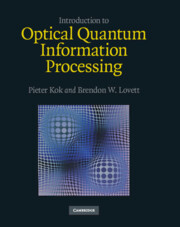Book contents
- Frontmatter
- Dedication
- Contents
- Preface
- Part I Quantum optics and quantum information
- 1 The quantum theory of light
- 2 Quantum information processing
- 3 Figures of merit
- Part II Quantum information in photons and atoms
- Part III Quantum information in many-body systems
- Appendix A Baker–Campbell–Haussdorff relations
- Appendix B The Knill–Laflamme–Milburn protocol
- Appendix C Cross–Kerr nonlinearities for single photons
- References
- Index
2 - Quantum information processing
from Part I - Quantum optics and quantum information
Published online by Cambridge University Press: 05 July 2014
- Frontmatter
- Dedication
- Contents
- Preface
- Part I Quantum optics and quantum information
- 1 The quantum theory of light
- 2 Quantum information processing
- 3 Figures of merit
- Part II Quantum information in photons and atoms
- Part III Quantum information in many-body systems
- Appendix A Baker–Campbell–Haussdorff relations
- Appendix B The Knill–Laflamme–Milburn protocol
- Appendix C Cross–Kerr nonlinearities for single photons
- References
- Index
Summary
In general, all forms of information processing can be considered in a quantum mechanical context, including for example communication, channel capacities, and the quantum limits to information extraction. In this chapter we introduce the basic features of quantum information processing. We first present qubits as abstractions of two-level addressable quantum systems, before generalizing this concept to higher-dimensional qudit systems, and continuous variables. We introduce the stabilizer formalism towards the beginning of our discussion as a convenient way to track quantum information. In Section 2.2 we derive the no-cloning theorem, which leads us to cryptography, teleportation, and quantum repeaters. Section 2.3 describes quantum computing with qubits. We start with a brief description of the circuit model, and use it to define cluster states and the one-way model. We study the properties of cluster states and discuss error correction. In the last section we introduce quantum computing over continuous variables.
Quantum information
Classically, information is carried by ‘bits’, which are physical systems that have two (macroscopic) states denoted by 0 and 1. These bits are described classically, which immediately raises the question of how we should extend this information-theoretic description to the quantum mechanical case. This will lead to the quantum unit of information, the quantum bit or ‘qubit’.
2.1.1 Classical and quantum bits
We can define the qubit as a two-dimensional quantum system, which means that the state space of the system is a two-dimensional complex Hilbert space ℋ.
- Type
- Chapter
- Information
- Introduction to Optical Quantum Information Processing , pp. 48 - 89Publisher: Cambridge University PressPrint publication year: 2010



